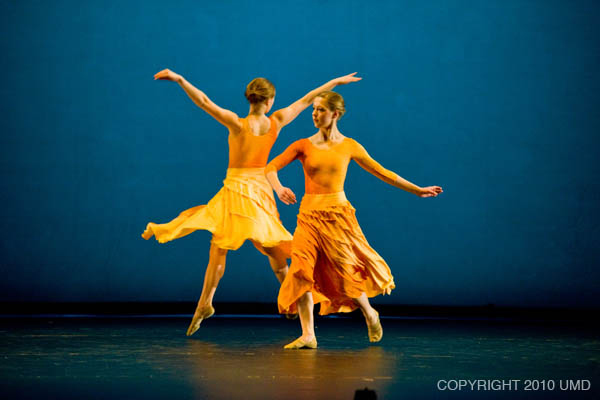
The
University of Minnesota Duluth
Department of Theatre
presents
Action/Reaction Dance Concert
| Artistic Director | Rebecca Katz Harwood |
| Special Guest Choreographer | Edisa Weeks |
| Technical Director | John Heil |
| Sound Designer | Nick Gosen |
| Stage Manager | Kelly Lasley |
February 11-13, 2010
The lighting design for the Action/Reaction Dance Concert was the result of fifteen months of research into the techniques of eight lighting designers who began their design careers lighting dance. Funding for this research was provided by the office of the Vice Chancellor for Academic Affairs at the University of Minnesota Duluth. The Action/Reaction Dance Concert was influenced by all of the designers in some capacity, but two in particular were influential.
Lighting designer Tom Skelton developed a method for cyc lighting in the 1960s that involved a bounce cyc and a rear projection screen. Instead of putting light directly on the down stage cyclorama seen by the audience, striplights from both below and above are focused upstage on a white cyc along the back wall of the performance space. Light would bounce off the white scrim onto a rear projection screen (Skelton referred to it as a plastic) which transmits light to the viewing public. The advantage of this system was a softly focused wash of light without any apparent source. The lighting for Action/Reaction used three colors of light from below installed in mini-striplights, and three colors from above from far cycs. The result was a beautifully lit background that lent itself to nearly every dance.
The second technique incorporated into the lighting for this production was learned at the Workshop in Light and Movement conducted by Dana Reitz and Jennifer Tipton. The six day workshop included a light plot to help designers and choreographers explore the relationship between light and movement. The light plot utilized comparatively high trims for a space with an 18'-0" proscenium height, and wide angle light fixtures that provided a single source of light for nearly the entire performance space. Ms. Tipton often referred to lighting the performance area as a "box of light."
With these techniques, the lighting for Action/Reaction was a vast improvement over what has been provided for past dance concert. Continued research into the techniques of pioneer dance lighting designers will hopefully contribute additional value to light's relationship to dance.
Vortex
Choreography by Ann Bergeron
Costume Design by Patricia Dennis
Lighting Design by Mark Harvey
 |
The emphasis of this dance was it's circular movement. Lighting focused on illuminating the skirts of the dancers to high light the flowing nature of the dance. Smooth transitions from one section of the dance to the next was supported by gentle changes in the lighting. |
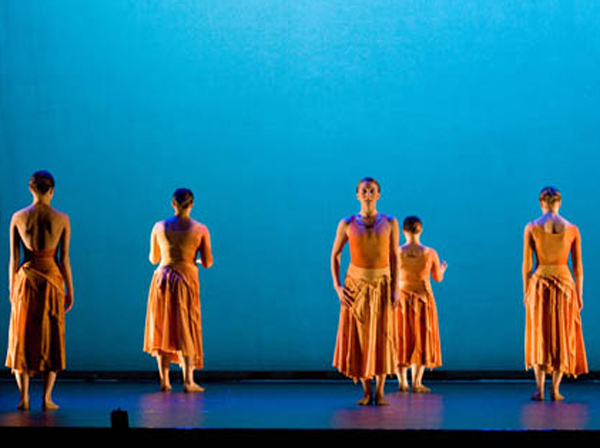 |
| The lighting became slightly surreal during a quiet, pensive section of the dance. Dark blue back light gave the floor the appearance of liquid while strong side light etched the dancer's figures in space. |
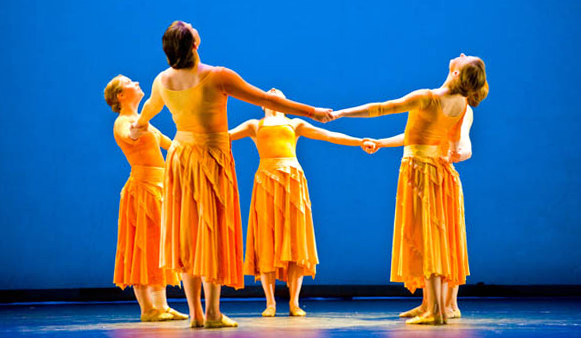 |
| The dance concluded with a circle light highlighting the dancers from above. |
What If
Choreography by Rebecca Katz Harwood in collaboration with the dancers
Costume Design by Erin Muhs
Lighting Design by Mark Harvey
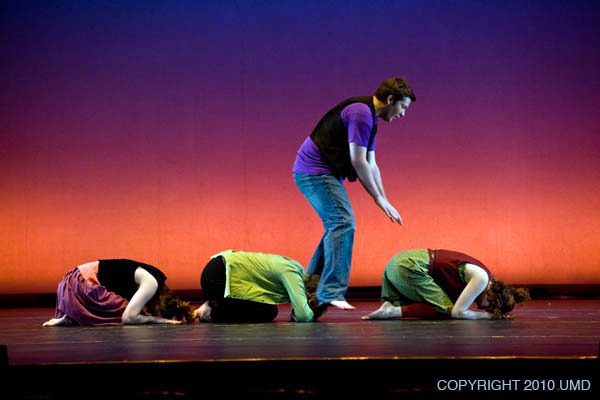 |
| This dance theatre piece tells the story of a group of children and their experiences and discoveries in their ever expanding world. Each dancer related childhood memories through movement and dialogue. The movement includes a fair amount of improvisation so the lighting's intent was to make the space bright and full. |
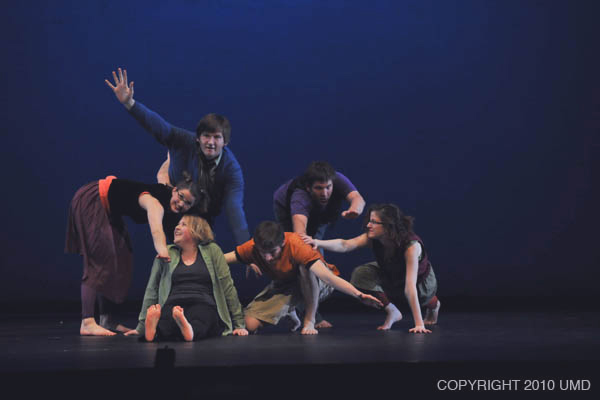 |
| A wistful mood developed as each performer described memories of the past. My intention was to emphasize the changing mood by altering the lighting to simulate the change of time of day as the dance progressed. Starting with a bright morning look, the lighting moves to mid-day, and then into evening as the dancers acknowledge the inevitability of growing older. |
Seven Stages
Choreography by LilaAnn Coates White
Costume Design by Jon Moyer-Grice
Lighting Design by Mark Harvey
Assistant Lighting Design by Colin Reibel
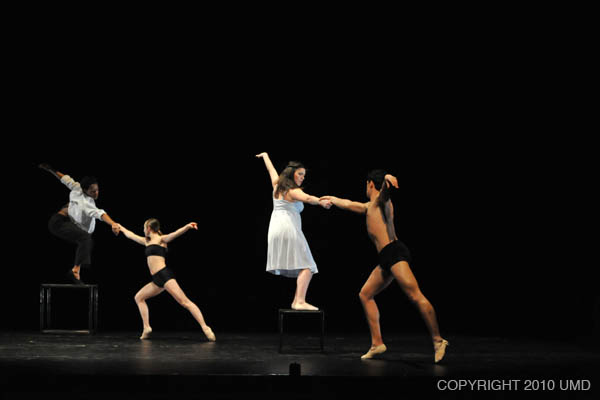 |
| Seven Stages explores the cycle of grief through personal relationships with death. Three dancers exemplify death, while three others represent one of the seven stages of grief: shock, denial, bargaining, guilt, anger, depression or acceptance. Lighting was kept in its simplest form, emphasizing angle and distribution. No color was used in the lighting and areas of light were tightly focused to the performance area in order to reveal each individual's relationship to death. |
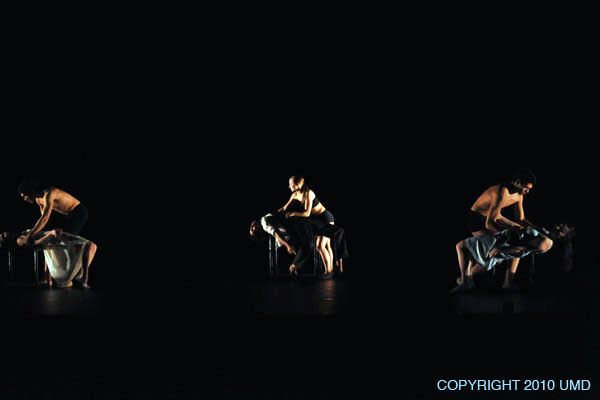 |
| Death figures are presented in black minimal costumes, while their victims wear white. At a crucial moment in the dance, each death character takes their victim into a submissive prone position. To emphasize this moment in the dance, light suddenly shifts into an "other-worldly" side light from a low angle. |
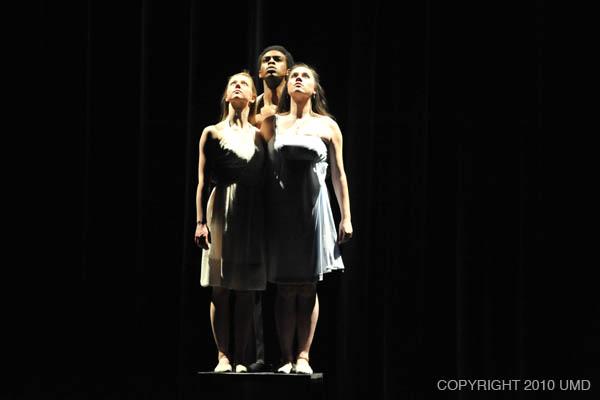 |
| The dance concludes with a tightly focused special on the three victims, creating an ascension feel to the conclusion of the dance. |
Ritual
Choreography by Thomas Rusterholtz
Costume and Make-up Design by Nina Escobedo
Lighting Design by Mark Harvey
Assistant Lighting Design by Scott Dahl
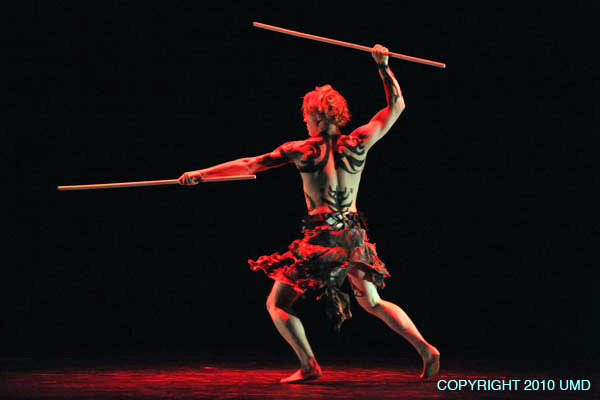 |
| Ritual was an emotionally powerful dance utilizing saturated color in the lighting. A red pool of back light begins the dance, adding white and amber from the sides as the dance develops. At the conclusion, the dancer collapses from exhaustion in a pool of deep blue light. |
We Are Slowly But Surely Achieving Our Objective
Choreography by Edisa Weeks in collaboration with the dancers
Lighting Design by Mark Harvey
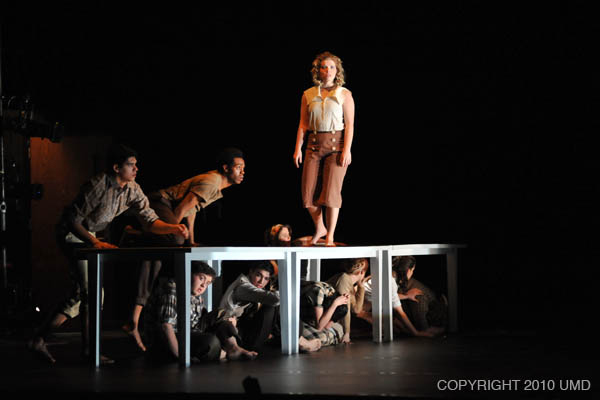 |
| We Are Slowly But Surely Achieving Our Objective offers political commentary concerning our roles as individuals and a nation at war. Bomb shelter scenes are conveyed in stark white light as the audience listens to war debriefing sessions from the George W. Bush administration. |
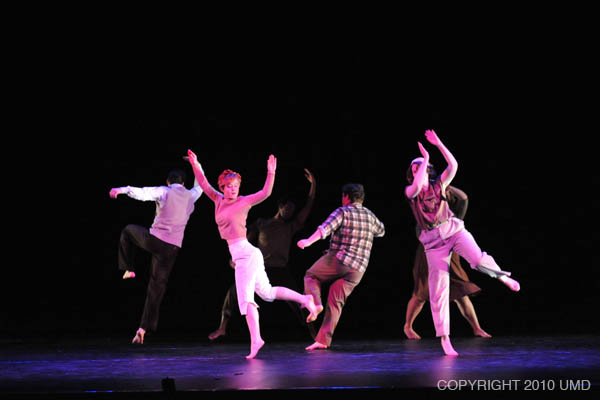 |
| Interspersed among the bomb shelter scenes are scenes of frivolity. The dancers suddenly break into a joyous, perhaps a bit too care-free dance, as the music plays "Come On, Be Happy." Lighting reflected this sudden change in the mood by shifting to colors of pink and blue. |
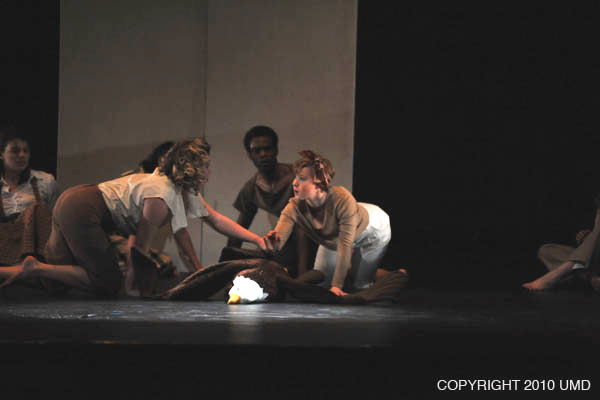 |
| A stuffed eagle, ominous symbol of the United States, is dropped from the flies; dancers construct a war munitions manufacturing plant with their bodies, and the dance concludes with a pile of dead bodies down center. |
Marathon
Choreography by Rebecca Katz Harwood in collaboration with the dancers
Costume Design by Karissa Toutloff
Lighting Design by Mark Harvey
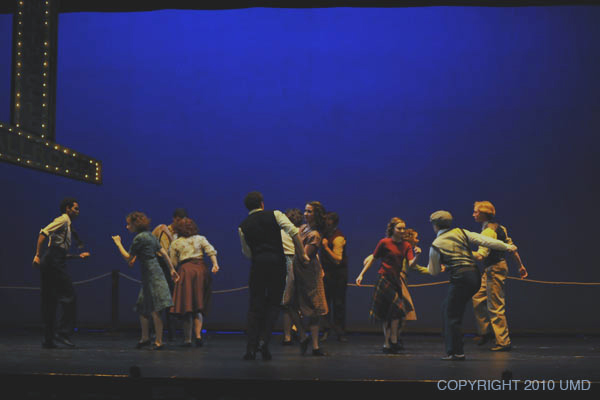 |
| Marathon is a dance that tells a story through movement. Six couples tell their individual stories of their participation in a dance marathon in 1935. The intent of the lighting was to establish a sense of period with amber light at the beginning of the piece. Follow spots were used to feature individual couples at various points in the dance. |
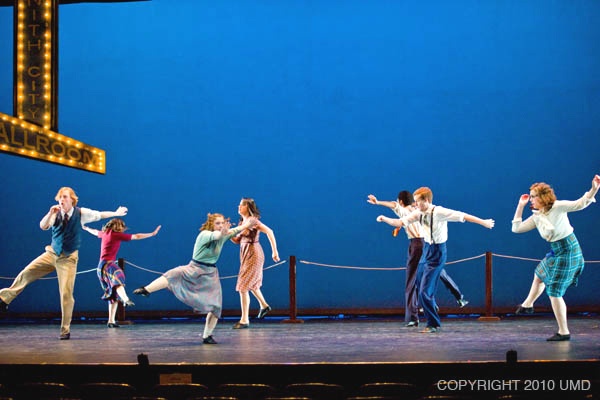 |
| Towards the end of the piece, dancers wracked with exhaustion suddenly seem to have gained a renewed energy and vitality. The lighting grows brighter to help convey the sense of seeing more of the contestants's dreams rather than their desperate reality. |
Choreography by Amber Burns
Costume Design by Erin Muhs
Lighting Design by Mark Harvey
Assistant Lighting Design by Jon Moyer-Grice
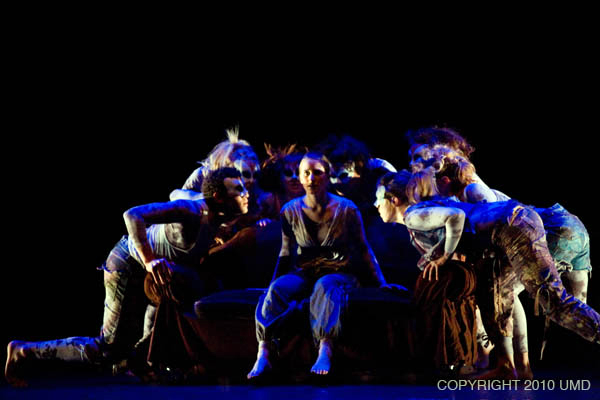 |
| The lighting for Hypnosis was intended to emphasize the isolation of the woman at the center of the dance. Surrounded by figures from her own psyche, the woman finds herself outside her own control. |
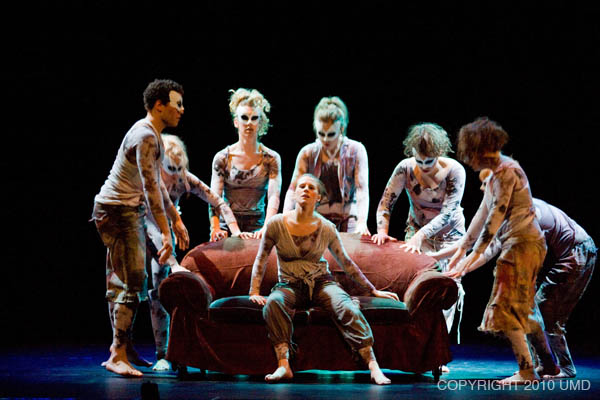 |
| A key component of the dance was the couch which served as a symbol of comfort and normalcy. The couch moves throughout the performance space, however, and the lighting attempted to underscore the paranoia of what's hidden just beyond our understanding, using dark blues and greens to emphasize her surreal state of mind. |
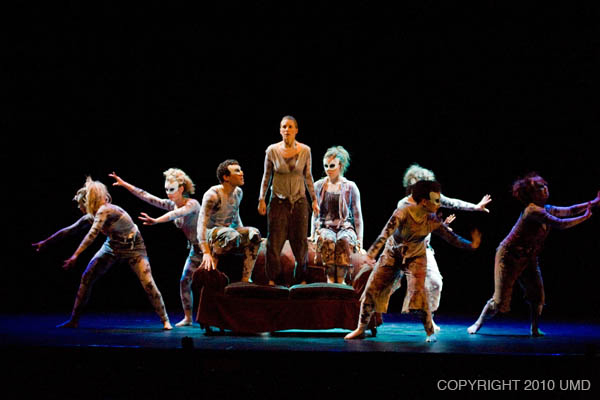 |
Exposed
Choreography by Caitlin Losure
Costume Design by Kaitlin Saltzman
Lighting Design by Mark Harvey
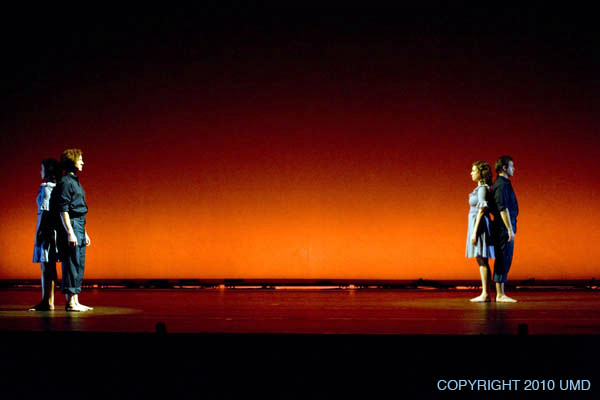 |
| Two couples are discovered in full silhouette at the beginning of Exposed. Both couples move as mirror images of one another. As time passes, however, one couple's movements reveal the every day struggles of life while the other couple continues in an idyllic setting. |
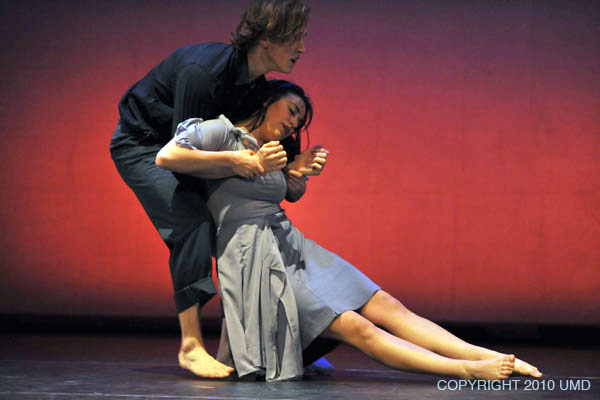 |
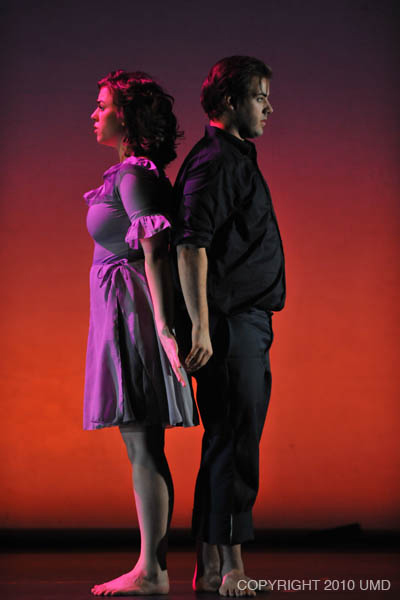 |
| The lighting for Exposed needed to show the relationship between the two couples as well as the developing contrasts between them. Lighting for the realistic couple stage right moved into a harsh pool of white light, emphasizing the tension between the two characters. Stage left, the light moved into a flattering, more romanticized colors. The dance concluded with the woman leaving the stage while the light fades back to a silhouette on the remaining three dancers. | |
Hunting and Gathering
Choreography and text by Ann Aiko Bergeron in collaboration with the dancers
Costume Design by Nina Escobedo
Lighting Design by Mark Harvey
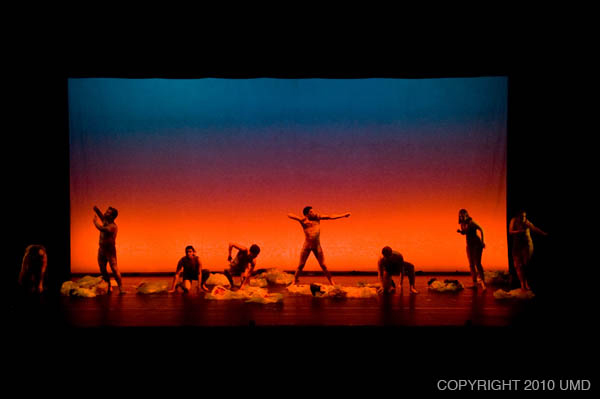 |
| Hunting and Gathering is a dance theatre piece that contrasts the cultures of Western society and the San/Bushmen tribe in Namibia. The dance begins and ends with movement and verbal descriptions of the simplistic lifestyle of the San/Bushmen. The lighting supported the slow simplistic movement with a fiery sunset in the background, and moving patterns of firelight on the dancers. |
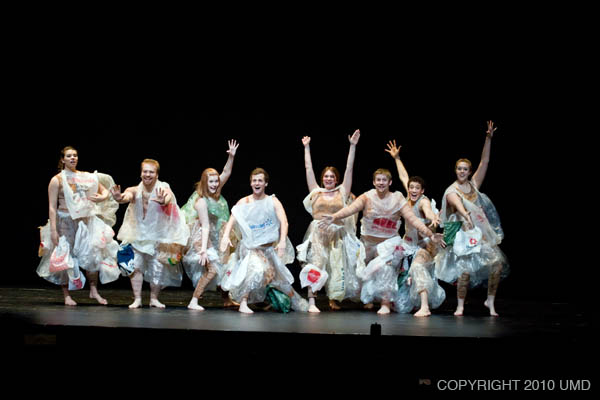 |
| In contrast, a sudden transition brought on by a flashing "blue light special", discovered performers who have shifted into consumer savvy personalities, revealing the many reasons Western society feels the need to collect things. Dressed in plastic bags, characters add objects they're unwilling to part with until they become so encumbered they can barely move. |
Out of Whack
Choreography by Ann Aiko Bergeron
Costume Design by Mariya Hawks
Lighting Design by Mark Harvey
Assistant Lighting Design by Alex Rugowski
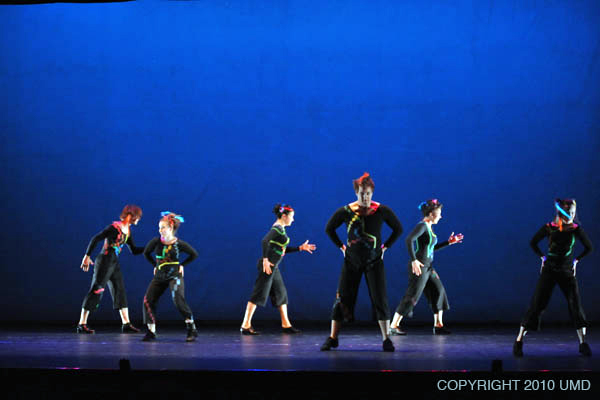 |
| The dance concert concluded with a high-energy combination of tap and break dancing. Lighting was intended to be bright to support the fast-paced action of the movement. |
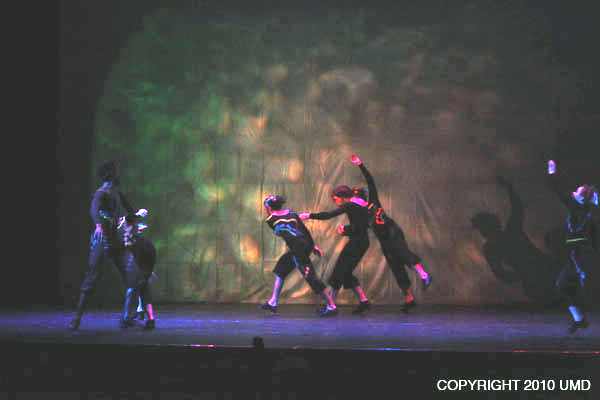 |
| At various points in the dance the music drops out of its steady rhythm into a swirl of sound. These moments were called "whacked out" and the dancers spun seemingly out of control. To support the feeling of pandemonium, swirling images were projected on the cyc using split gels and glass gobos in a pair of Twin Spin gobo rotators. |
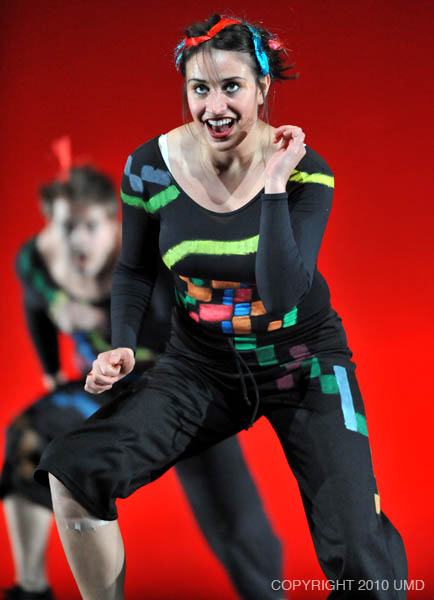 |
| The dance concluded with a bright red cyc which contrasted nicely with the performers costumes. |